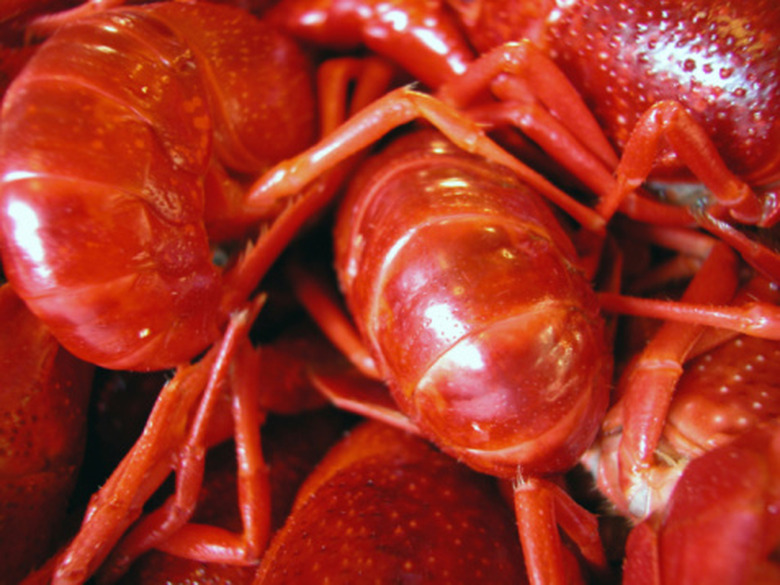Differences Between Crayfish & Grasshoppers
Crayfish and grasshoppers are familiar sights and are easily recognizable. But knowing how to explain the main differences between them could make an interesting school project on the natural world. Both are interesting creatures and a few well selected facts will enlighten any report.
Crayfish Taxonomy
Crayfish Taxonomy
Crayfish are classified as decapod crustaceans. This is the same family group of invertebrate crustaceans that includes prawns, lobsters, crabs and shrimps. There are over 600 species and sub-species of crayfish grouped in 3 main family groups: Astacidae; Cambaridae; and Parastacidae. A new species of crayfish twice the size of other local species was discovered in 2010 in Tennessee. Crayfish are found around the world in fresh water courses and the seas.
Crayfish Anatomy
Crayfish Anatomy
Crayfish are readily identifiable by the large set of pincers that stretch out in front to help them find and eat food. Crayfish have a further four sets of legs on which they walk. The hard back shell is called a carapace. This provides protection from predators. Crayfish also have a long muscular abdomen with several protective plates that allow both for movement and further protection. When crayfish are growing they must shed this old hard outer shell, called an exoskeleton. A crack appears between the carapace and the abdomen to allow the crayfish to wriggle free from its old exoskeleton. Crayfish are omnivorous, eating anything from vegetable matter to other sea creatures like small shrimp or larvae.
Cooking with Crayfish
Cooking with Crayfish
Crayfish are considered a delicacy in many countries around the world. They are commonly boiled in salted water before their shells are cracked open and the tender flesh is eaten. The meat in the tail is the most prized for its delicate flavor. A key ingredient in Cajun and Creole cooking, crayfish are also widely consumed in Europe, especially Scandinavia. The fresh cool waters on Scotland's western coast are renowned for some of the best crayfish in Europe with much of the production exported to mainland Europe.
In the United Kingdom, North American signal crayfish were introduced to boost supplies available for consumption. However, this predatory crustacean is causing major problems for the indigenous species and much work is now being undertaken to eliminate established populations of the North American invader from British waterways.
Grasshopper Taxonomy
Grasshopper Taxonomy
Grasshoppers are insects and are classified in three main family groups: Tettigoniidae (long-horned grasshoppers and katydids); Tetrigidae (pygmy grasshoppers); and Acrididae (short-horned grasshoppers). In the USA there are over 400 known species of grasshopper known in the 17 western states, but over 10,000 different species have been classified from all over the world. Adult grasshoppers lay eggs from which the young, wingless insects hatch. Grasshoppers shed their skins several times like crayfish as they grow before finally emerging as winged adults.
Grasshopper Anatomy
Grasshopper Anatomy
Grasshoppers have a body divided into three parts: head; thorax; and abdomen. Three pairs of legs grow from the thorax. Grasshoppers possess a sturdier set of front wings that protect the rear wings from accidental damage. Grasshoppers are herbivores that often eat vegetation indiscriminately. Swarms of grasshoppers can cause major damage to crops and their management is therefore important in agricultural areas.
Cite This Article
MLA
Smith, Alasdair. "Differences Between Crayfish & Grasshoppers" sciencing.com, https://www.sciencing.com/differences-between-crayfish-grasshoppers-8150369/. 22 November 2019.
APA
Smith, Alasdair. (2019, November 22). Differences Between Crayfish & Grasshoppers. sciencing.com. Retrieved from https://www.sciencing.com/differences-between-crayfish-grasshoppers-8150369/
Chicago
Smith, Alasdair. Differences Between Crayfish & Grasshoppers last modified March 24, 2022. https://www.sciencing.com/differences-between-crayfish-grasshoppers-8150369/
